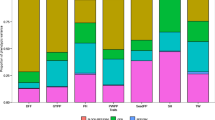Abstract
The Ethiopian peasant farms are characterized by highly varied micro-environments differing in characteristics such as topography, soil type, water, temperature and fertility. The bulk of the durum wheat planting material currently in use on these farms is largely represented by traditional farmers' varieties/landraces.
These traditional farmers' varieties/landraces generally, are stable but low yielding, and often fail to adequately meet the level of productivity essential for production beyond subsistence level, unless they are enhanced to improve their competitiveness with modern varieties in respect to yield. Improving the productivity of landraces, while maintaining an appreciable level of genetic diversity is crucial to yield stability. This could be achieved by developing composites that are formed by bulking together three or more potentially high yielding spikes (agrotypes) that vary for various morphologic and agronomic characteristics, but due to their similarity in plant height, maturity, glume color and seed color give the composite a uniform field appearance like a modern variety.
Similar content being viewed by others
References
Bekele, E., 1984. Analysis of regional patterns of phenotypic diversity in Ethiopian tetraploid and hexaploid wheats. Hereditas 100: 131-154.
Feldman, M., 1976. Wheats. In: N.W. Simmonds (Ed.), Evolution of Crop Plants, pp. 120-128. Longman Groups Limited, London.
Tesemma, T., G. Belay & M. Worede, 1991. Morphological diversity in tetraploid wheat landrace populations from Central Highlands of Ethiopia. Hereditas 114: 171-176.
Tesemma, T. & Getachew Belay, 1991. Aspects of Ethiopian tetraploid wheats with emphasis on durum wheat genetics and breeding research. In: Hailu Gebre-Mariam, D.G. Tanner & Mengistu Hulluka (Eds.), Wheat Research in Ethiopia: A Historical Perspective, pp. 47-71. IAR/CIMMYT, Addis Ababa.
Tesemma, T., H.C. Becker, G. Belay, D. Mitiku, E. Bechere & S. Tsegaye, 1993. Performance of Ethiopian tetraploid wheat landraces at their collection sites. Euphytica 71: 221-230.
Tesemma, T., 1996. Low agricultural inputs: opportunities on farmer based approach to landrace conservation, enhancement and utilization. A paper presented at CRDA workshop on Agricultural Extension held on 19 March, 1996, Addis Ababa, Ethiopia.
Worede, M., 1993. The role of Ethiopian farmers in the conservation and utilization of crop genetic resources. In: D.R. Buxton, R.A. Shibles, R.A. Forsberg, B.L. Blad, H.A. Assay, G.M. Paulsen & R.F. Wilson (Eds.), Intl Crop Science I, pp. 395-399. Crop Science Society of America, Inc, Madison, Wisconsin, USA.
Worede, M., 1996. SoS/E working towards food security. In: Leyla Alyanak (Ed.), Voices of Africa, Sustainable Development, Issue No. 6, pp. 45-51. UN-NGLS, Palais des Nations, CH-1211, Geneva, Switzerland.
Author information
Authors and Affiliations
Rights and permissions
About this article
Cite this article
Tesemma, T., Bechere, E. Developing elite durum wheat landrace selections (composites) for Ethiopian peasant farm use: Raising productivity while keeping diversity alive. Euphytica 102, 323–328 (1998). https://doi.org/10.1023/A:1018360432426
Issue Date:
DOI: https://doi.org/10.1023/A:1018360432426




